Tan Son Nhat International Airport
Tân Sơn Nhất International Airport (IATA: SGN, ICAO: VVTS) (Vietnamese: Sân bay quốc tế Tân Sơn Nhất, Vietnamese: Cảng hàng không quốc tế Tân Sơn Nhất) is the busiest airport in Vietnam with 32.5 million passengers in 2016[2] and 38.5 million passengers in 2018.[3] It serves Ho Chi Minh City as well as the rest of southeastern Vietnam. As of January 2017, it had a total capacity of only 25 million passengers,[4] which has caused constant congestion and sparked debate for expanding or building a new airport. The airport's IATA code, SGN, is derived from the city's former name of Saigon.
Tân Sơn Nhất International Airport Sân bay Quốc tế Tân Sơn Nhất | |||||||||||||||
|---|---|---|---|---|---|---|---|---|---|---|---|---|---|---|---|
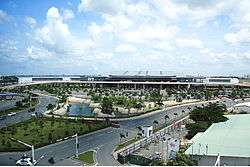 | |||||||||||||||
| |||||||||||||||
| Summary | |||||||||||||||
| Airport type | Public / Military | ||||||||||||||
| Owner | Government of Vietnam | ||||||||||||||
| Operator | Airports Corporation of Vietnam | ||||||||||||||
| Serves | Ho Chi Minh City, Vietnam | ||||||||||||||
| Location | Tan Binh District | ||||||||||||||
| Hub for |
| ||||||||||||||
| Elevation AMSL | 10 m / 33 ft | ||||||||||||||
| Coordinates | 10°49′08″N 106°39′07″E | ||||||||||||||
| Website | vietnamairport.vn/tansonnhatairport/en/ | ||||||||||||||
| Map | |||||||||||||||
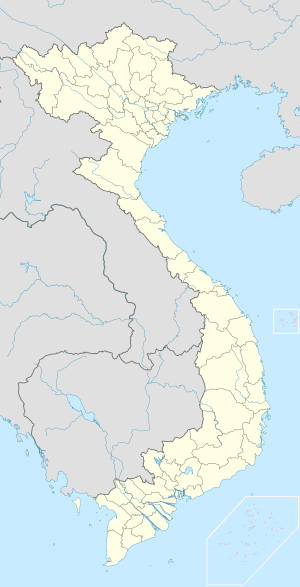 SGN/VVTS Location of the airport in Ho Chi Minh City, Vietnam  SGN/VVTS SGN/VVTS (Southeast Asia)  SGN/VVTS SGN/VVTS (Asia) | |||||||||||||||
| Runways | |||||||||||||||
| |||||||||||||||
| Statistics (2017) | |||||||||||||||
| |||||||||||||||
Source: ACV[1] | |||||||||||||||
Of the routes the airport offers, the Ho Chi Minh City - Hanoi route is the busiest in Southeast Asia and the sixth busiest in the world, serving 6,867,114 customers in 2018.[5]
History
Tan Son Nhat International Airport has its origins in the early 1930s when the French colonial government constructed a small airport with unpaved runways, known as Tân Sơn Nhứt Airfield near the village of Tan Son Nhut. By mid-1956, with U.S. aid, a 7,200-foot (2,190 m) runway had been built; the airfield near Saigon became known as South Vietnam's principal international gateway. During the Vietnam War (or Second Indochina War), Tan Son Nhut Air Base (then using the alternative spelling Tân Sơn Nhứt) was an important facility for both the U.S. Air Force and the Republic of Vietnam Air Force. Between 1968 and 1974, Tan Son Nhut Airport was one of the busiest military airbases in the world. Pan Am schedules from 1973 show that during the last days of South Vietnam, Boeing 747 service was being operated four times a week to San Francisco via Guam and Manila.[6] Continental Airlines operated up to 30 Boeing 707 military charters per week to and from Tan Son Nhut Airport during the 1968–74 period.[7]
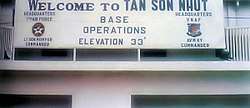
Post-war era
On 9 December 2004, United Airlines became the first U.S. airline to fly to Vietnam since Pan Am's last flight during the Fall of Saigon in April 1975. Flight UA 869, operated using a Boeing 747-400 landed at Ho Chi Minh City, the terminus of the flight that originated from San Francisco via Hong Kong. On 29 October 2006, this service was switched from San Francisco to Los Angeles with a stop in Hong Kong, operating as UA 867 (also using a 747-400). In 2009, the service UA 869 has resumed once again from San Francisco via Hong Kong International Airport.[8] United ended the route to San Francisco via Hong Kong on 30 October 2011. The airline resumed the route from Ho Chi Minh City to Hong Kong after its merger with Continental Airlines. The flight no longer makes a stop at San Francisco and it was flown on a Boeing 777-200ER instead of the 747-400.
In 2006, Tan Son Nhat International Airport served approximately 8.5 million passengers (compared with 7 million in 2005) with 64,000 aircraft movements.[9] It has recently accounted for nearly two-thirds of the arrivals and departures at Vietnam's international gateway airports.[10][11] Due to increasing demand (about 15–20% per annum), the airport has been continuously expanded by the Southern Airports Corporation.[11]
In 2010, Tan Son Nhat domestic terminal handled 8 million passengers, its maximum capacity. The airport reached its full capacity of 20 million passengers in 2013, two years earlier than predicted. Both domestic and international terminal are being expanded to meet the increasing demand. In December 2014, expansion for the domestic terminal was finished, boosting the terminal's capacity to 13 million passengers per annum.[12] In September 2017, People's Army of Vietnam ceded 21 hectare of military land in the vicinity of the airport to Airports Corporation of Vietnam for civil use. This gave way for the construction of 21 new aircraft parking spaces, expected to be completed by Tet holidays in 2018. Tan Son Nhat will then have 72 parking spaces for airplanes.[13]
Of the routes the airport offers, the Ho Chi Minh City - Hanoi route is the busiest in Southeast Asia and the seventh busiest in the world, serving 6,769,823 customers in 2017.[14]
International terminal
A new international terminal funded by Japanese official development assistance and constructed by a consortium of four Japanese contractors (KTOM, abbreviation of four contractors' names: Kajima – Taisei – Obayashi – Maeda), opened in September 2007 with an initially designed capacity of 10 million passengers a year.[15] In 2014, the terminal served over 9 million international passengers[16] and a demand of an expansion to the terminal was in sight. The first phase of an urgent expansion to the terminal was finished in December 2016 with an addition of 2 new jet bridges and other facilities.[17] Upon the completion of phase two, the terminal can handle 13 million passengers annually.[18]
Facilities
Following the opening of its new international terminal in September 2007, Tan Son Nhat has two major terminal buildings with separate sections for international and domestic flights.
The Prime Minister of Vietnam, by Decision 1646/TTg-NN, has approved the addition of 40 hectares (99 acres) of adjacent area to extend the apron and to build a cargo terminal to handle the rapid increase of passenger (expected to reach 17 million in 2010, compared to 7 million and 8.5 million in 2005 and 2006 respectively) and cargo volume at the airport.[10][19]
Airlines and destinations
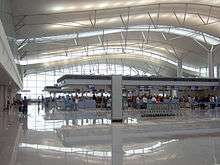
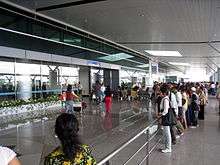
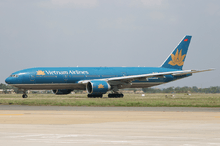

_from_Cathay_Pacific_(10406599303).jpg)
.jpg)
Passenger
| Airlines | Destinations |
|---|---|
| Aeroflot | Moscow–Sheremetyevo |
| AirAsia | Johor Bahru[20], Kuala Lumpur–International, Penang |
| Air Busan | Busan[21] |
| Air China | Beijing–Capital (Suspended) |
| Air France | Paris–Charles de Gaulle |
| All Nippon Airways | Tokyo–Haneda,[22][23][24] Tokyo–Narita |
| Asiana Airlines | Seoul–Incheon (Suspended) |
| Bamboo Airways | Da Nang, Dong Hoi, Hai Phong, Ha Long, Hanoi, Phu Quoc, Quy Nhon, Thanh Hoa, Vinh Charter: Ibaraki[25] |
| Cambodia Angkor Air | Phnom Penh, Siem Reap, Sihanoukville |
| Cathay Pacific | Hong Kong |
| Cebu Pacific | Manila |
| China Airlines | Taipei–Taoyuan |
| China Eastern Airlines | Kunming, Shanghai–Pudong |
| China Southern Airlines | Beijing–Daxing, Guangzhou, Shanghai–Pudong, Shenzhen, Wuhan (suspended until 24 October 2020 due to coronavirus outbreak)[26][27] |
| Chongqing Airlines | Chongqing |
| Druk Air | Charter: Guwahati, Paro[28] |
| Edelweiss Air | Seasonal: Zürich[29] |
| Emirates | Dubai–International |
| EVA Air | Taipei–Taoyuan |
| Finnair | Seasonal: Helsinki |
| IndiGo | Kolkata[30] |
| Japan Airlines | Tokyo–Haneda, Tokyo–Narita |
| Jeju Air | Seoul–Incheon (Suspended) |
| Jetstar Airways | Melbourne, Sydney |
| Jetstar Asia Airways | Singapore |
| Jetstar Pacific Airlines | Bangkok–Suvarnabhumi, Buon Ma Thuot, Chu Lai, Da Lat, Da Nang, Dong Hoi, Hai Phong, Hanoi, Hue, Nha Trang, Phu Quoc, Quy Nhon, Singapore, Thanh Hoa, Tuy Hoa, Vinh |
| Korean Air | Seoul–Incheon (Suspended) |
| Lao Airlines | Pakse, Vientiane |
| LOT Polish Airlines | Seasonal charter: Warsaw–Chopin |
| Malaysia Airlines | Kuala Lumpur–International |
| Malindo Air | Kuala Lumpur–International |
| Mandarin Airlines | Taichung |
| Nok Air | Bangkok–Don Mueang |
| Philippine Airlines | Manila |
| Philippines AirAsia | Manila[31] |
| Qatar Airways | Doha, Phnom Penh |
| Royal Brunei Airlines | Bandar Seri Begawan |
| Ruili Airlines | Kunming[32] |
| Scoot | Singapore |
| Sichuan Airlines | Chengdu,[33] Nanning |
| Singapore Airlines | Singapore |
| Thai AirAsia | Bangkok–Don Mueang |
| Thai Airways | Bangkok–Suvarnabhumi |
| Thai Vietjet Air | Pattaya–U-Tapao[34] Udon Thani [35] |
| Turkish Airlines | Istanbul[36] |
| T'way Air | Seoul–Incheon (Suspended) |
| Uni Air | Taipei–Taoyuan |
| VietJet Air | Bangkok–Suvarnabhumi, Buon Ma Thuot, Chiang Mai, Chu Lai, Da Lat, Da Nang, Delhi,[37] Denpasar/Bali,[38] Dong Hoi, Hai Phong, Ha Long, Hanoi, Hong Kong, Hue, Kaohsiung, Kuala Lumpur–International, Mumbai (begins 15 May 2020),[39] Nha Trang, Osaka–Kansai,[40] Phuket, Phu Quoc, Pleiku, Qui Nhon, Seoul–Incheon (Suspended), Singapore, Taichung, Tainan, Taipei–Taoyuan, Thanh Hoa, Tokyo–Narita,[41] Vinh |
| Vietnam Airlines | Bangkok–Suvarnabhumi, Buon Ma Thuot, Busan (Suspended), Chu Lai, Da Lat, Da Nang, Denpasar/Bali,[42] Dong Hoi, Frankfurt, Fukuoka, Guangzhou, Haikou,[43] Hai Phong, Ha Long,[44] Hanoi, Hong Kong, Hue, Jakarta–Soekarno-Hatta, Kaohsiung, Kuala Lumpur–International, London–Heathrow, Melbourne, Nagoya–Centrair, Nha Trang, Osaka–Kansai, Paris–Charles de Gaulle, Phnom Penh, Phuket,[42] Phu Quoc, Pleiku, Qui Nhon, Seoul–Incheon (Suspended), Shanghai–Pudong, Shenzhen,[45] Siem Reap, Singapore, Sydney, Taipei–Taoyuan, Thanh Hoa, Tokyo–Narita, Vientiane, Vinh, Yangon |
| Vietnam Airlines operated by VASCO | Ca Mau, Con Dao, Rach Gia |
| XiamenAir | Xiamen |
Cargo
| Airlines | Destinations |
|---|---|
| AirBridgeCargo | Hong Kong, Moscow-Sheremetyevo |
| Asiana Cargo | Seoul–Incheon |
| Cardig Air | Jakarta-Soekarno–Hatta, Shenzhen |
| Cargolux | Luxembourg, Hong Kong |
| Cathay Pacific Cargo | Hong Kong |
| China Airlines Cargo | Hanoi, Taipei–Taoyuan |
| China Southern Cargo | Guangzhou, Hanoi |
| DHL Aviation operated by Air Hong Kong | Hong Kong, Penang |
| Emirates SkyCargo | Dubai-Al Maktoum |
| Etihad Cargo | Abu Dhabi |
| FedEx Express | Guangzhou, Hanoi, Jakarta–Soekarno–Hatta |
| Hong Kong Air Cargo | Hong Kong |
| Korean Air Cargo | Seoul–Incheon |
| MASkargo | Kuala Lumpur–International |
| Qatar Airways Cargo | Doha |
| Raya Airways | Kuala Lumpur-Subang, Labuan |
| Turkish Airlines Cargo | Istanbul-Atatürk, Kuala Lumpur–International |
Statistics
| Rank | Destinations | Frequency (Weekly) |
|---|---|---|
| 1 | 103 | |
| 2 | 102 | |
| 3 | 81 | |
| 4 | 77 | |
| 5 | 63 | |
| 6 | 42 | |
| 7 | 42 | |
| 8 | 42 | |
| 9 | 39 | |
| 10 | 35 | |
| 11 | 21 | |
| 12 | 19 | |
| 13 | 15 | |
| 14 | 14 | |
| 15 | 12 | |
| 16 | 11 | |
| 17 | 4 | |
| 18 | 21 | |
| 19 | 9 | |
| 20 | 9 | |
| 21 | 14 | |
| 22 | 14 | |
| 23 | 7 | |
| 24 | 7 | |
| 25 | 7 | |
| 26 | 7 | |
| 27 | 7 | |
| 28 | 7 | |
| 29 | 7 | |
| 30 | 6 | |
| 30 | 7 | |
| 31 | 6 | |
| 32 | 5 | |
| 33 | 7 | |
| 34 | 3 | |
| 35 | 3 | |
| 36 | 3 | |
| 37 | 2 | |
| 38 | 1 |
| Rank | Destinations | Frequency (Weekly) |
|---|---|---|
| 1 | Hà Nội | 596 |
| 2 | Đà Nẵng | 226 |
| 3 | Hải Phòng | 94 |
| 4 | Thanh Hóa | 63 |
| 5 | Huế | 91 |
| 6 | Phú Quốc | 107 |
| 7 | Nha Trang | 111 |
| 8 | Vinh | 92 |
| 9 | Đà Lạt | 48 |
| 10 | Quy Nhơn | 42 |
| 11 | Côn Đảo | 64 |
| 12 | Buôn Ma Thuột | 39 |
| 13 | Pleiku | 32 |
Aircraft movement
Number of passengers
Ground transportation
Bus and shuttle
A bus station is situated in front of the international terminal and is served by Ho Chi Minh City Bus. It is connected to the city center by bus line 109 and 152 as well as shuttle bus line 49. Connecting the airport to Vung Tau and other cities in Mekong Delta are express minibus services as well as bus line 119 (via Mien Tay Bus Station).[47]
Metro
The airport is expected to be served by Ho Chi Minh City Metro Line 4B, connected to Line 4 and 5 with services to the southern and eastern area of the city. However, it is currently not known when the line will be constructed.[48]
Taxi
There are several options for getting a taxi from the airport to the city
- Main taxi queue. The main taxi queue is on your left when you exit through the main door on the ground floor of the terminal building. When you get in the car, ask the driver to turn the meter on. Traditional taxi brands such as Vinasun and Mai Linh operate at the airport alongside with rideshare service Grab.[49]
- SASCO Travel counter in the terminal building. The SASCO Travel has a counter that is on your left after you clear customs. You can order and pay for a taxi from the staff member there or just book online beforehand. The cost will be display on the website and you know exactly how much you have to pay. After that, our person will then lead you out of the terminal building to the taxi queue and arrange a SASCO Travel car for you.[50]
- Other pre-paid taxi counters at the airport. There are also quite a few other counters after clearing customs, though still within the airport building, where they sell prepaid taxi vouchers such as ACV Unico, Song Viet...
Road
Until 2016, the airport only had one main access route via Truong Son Street, which caused chronic congestion for traffic going in and out of the airport. As an effort to ease traffic bottleneck, in August 2016, Pham Van Dong Boulevard officially opened and connected the airport to National Route 1A in an intersection east of the airport.[51]
Accidents and incidents
Throughout its history there have been several incidents that happened at the airport, some of the most notable are summarized below:
- On 4 April 1975, a Lockheed C-5A Galaxy, operated by the United States Air Force as part of Operation Babylift en route to Clark Air Base in the Philippines, crashed on approach during an emergency landing. Out of 328 people on board (311 passengers and 17 crew members), 155 people were killed.[52]
- On 12 January 1991, a Vietnam Airlines-operated Tupolev Tu-134, registration VN-A126, with 76 passengers on board crashed on final approach to Ho Chi Minh City. At 30 ft (9.1 m), the Tupolev suddenly lost height and landed hard, touched down with the left main gear first. There were no casualties but the aircraft was written off due to substantial damage.[53]
- On 4 September 1992, Vietnam Airlines Flight 850, an Airbus A310-300 en route from Bangkok to Ho Chi Minh City, was hijacked by Ly Tong, a former pilot in the Republic of Vietnam Air Force. Tong proceeded to drop anti-communist leaflets over Ho Chi Minh City before parachuting out of an emergency exit. Vietnamese security forces arrested him on the ground two hours later. The aircraft landed safely, and no one on board was injured.[54]
- On 20 November 2014, the 3-unit uninterruptible power supply of Ho Chi Minh City Area Air Control Center went offline, causing a blackout to the center that oversees air traffic from and to Tan Son Nhat from 11:05 AM to 12:19 PM. This incident also disabled the radar system, halting air traffic control capabilities. Overall, 92 flights were affected, 54 of them were within Ho Chi Minh flight information region and 8 were preparing to land at Tan Son Nhat at the time of the incident. No air traffic accident occurred and operations fully resumed by noon the next day.[55]
- On 22 April 2017, Tan Son Nhat International Airport was the site of an alleged terrorist attack. Two remotely controlled petrol bombs were planted at the airport, one in the International Terminal while the other was placed in the airport's parking garage. The bomb in the terminal failed to detonate due to internal sabotage. The bomb in the garage initially also failed to detonate because the activator was out of range. It was subsequently moved and set off in the International Terminal's departure hall where the first bomb was originally placed. No one was injured nor killed in the attack. A total of 15 people were arrested for involvement in the attack, according to the Vietnamese state media.[56]
Future plans
New Airport
Tan Son Nhat International Airport is located inside the crowded urban core of Ho Chi Minh City, making expansions difficult. In a report submitted to the Vietnamese National Assembly in 2015, legislators deemed continued expansion of Tan Son Nhat problematic in five aspects. Firstly, it would be more economically viable to build a new airport rather than extensively upgrade Tan Son Nhat. An estimated US$9.1 billion was reportedly needed for a new 4,000 m runway, a new passenger terminal and other facilities at Tan Son Nhat. Secondly, Tan Son Nhat airspace overlaps with that of Bien Hoa Airport, which is currently reserved for national defense purpose. A reduction in military activities in Bien Hoa is considered to be temporary and unsustainable. At the same time, Tan Son Nhat also acts as a strategic location in national defense; therefore, the airport cannot be used entirely for civic air transport. Additionally, due to its urban location, aside from increasing ground traffic stress in its access points, the airport cannot operate between midnight and 5AM in accordance to the International Civil Aviation Organization sustainable development goals, further limiting its capability.[57]
Following Decision 703/QĐ-TTg by the Vietnamese Prime Minister in July 2005, a new airport—Long Thanh International Airport—was planned to replace Tan Son Nhat airport for international departure use.[58] The initial master plan for the new airport was publicly announced in December 2006.[59] The new airport will be built in Long Thành District, Đồng Nai Province, about 40 km (25 mi) east of Ho Chi Minh City and 65 km (40 mi) north of the petroleum-focused city of Vung Tau, near Highway 51A.
According to the approved modified plan in 2011, Long Thanh International Airport will be constructed on an area of 50 square kilometers (19 sq mi), and will have four runways (4,000 m x 60 m or 13,100 ft x 200 ft) and be capable of receiving the Airbus A380. The project will be divided in three stages. Stage One calls for the construction of two parallel runways and a terminal with a capacity of 25 million passengers per year, due to be completed in 2020. Stage Two is scheduled for completion in 2030, giving the airport three runways, two passenger terminals and a cargo terminal designed to receive 1.5 million metric tons of cargo and 50 million passengers per year. The final stage is scheduled to be initiated after 2035, envisioned to handle 100 million passengers, 5 million metric tons of cargo annually on an infrastructure of 4 runways and 4 passenger terminals. The total budget for the first stage alone was estimated to be US$6.7 billion.[58]
Expansion
Because Long Thanh will not be ready for service until at least 2025, Tan Son Nhat must expand to meet the increasing demand. In January 2017, Airport Design and Construction Consultancy (ADCC) presented 3 proposals to expand the airport. Vietnam's Deputy Prime Minister Trịnh Đình Dũng agreed to proceed a US$860 million upgrade proposal for final review before submitting to the government. Under the chosen proposal, there would be a new mixed-use Terminal 3 and a civil-use Terminal 4 (to be built on the south side of the airport), a parallel taxiway between the existing runways and technical hangars on the northeast. The estimated time to complete the upgrade would be 3 years and the airport would then have a capacity of 43-45 million passengers annually.[60] The decision was controversial due to the fact that the golf course immediately north of SGN would remain untouched despite the urgent need of airport expansion.[61] The Minister of Transport Trương Quang Nghĩa explained that the airport could not be expanded northward due to costs and environmental impact.[62] On 12 June 2017, Prime Minister Nguyễn Xuân Phúc requested the Ministry of Transport to research the prospect of constructing a third runway at Tan Son Nhut International Airport. The French consulting company ADP Ingénierie (ADPi) was subsequently hired to provide a second opinion for the project.
In March 2018, ADPi presented their plan for the expansion. The firm advised against the construction of a third runway and supported a southward expansion plan. Without a new runway, Tan Son Nhut has a maximum capacity of 51 million passengers per year - a number ADPi predicted SGN to reach in 2025, in time for the opening of Long Thanh.[63] However, an independent consultancy of Ho Chi Minh City believed it could reach up to 80 million by the time Long Thanh was supposed to open, in accordance with reports by Boeing or the International Air Transport Association. As such, they proposed a three-phase northward expansion plan that would see a new runway and two new terminals to increase the airport's capacity to 70 million passengers per year.[64]
On 28 March 2018, Prime Minister Nguyễn Xuân Phúc ultimately selected the ADPi proposal as the basis for the expansion of the airport. This proposal includes a new Terminal 3 with a designed capacity of 20 million passengers per year south of Runway 07R/25L, additional facilities in the north area where a golf court currently occupies as well as improvements and constructions of access points for the airport.[65]
See also
- Bombing of Tan Son Nhut Air Base
- Da Nang International Airport
- Long Thanh International Airport
- Noi Bai International Airport
- List of airports in Vietnam
References
- "Cảng HKQT Tân Sơn Nhất: Top 10 sân bay với năng lực phục vụ 30-40 triệu khách/năm tốt nhất thế giới". Airports Corporation of Vietnam (in Vietnamese). Retrieved 24 March 2018.
- "ACV: Hội nghị tổng kết công tác năm 2016 và triển khai kế hoạch năm 2017". ACV. 20 January 2017. Retrieved 25 January 2017.
- "Tân Sơn Nhất không lo sân đỗ, chỉ sợ tắc đường (Tan Son Nhat will have no problem with the apron capacity, only with the congested roads surrounding the airport)" (in Vietnamese). bao giao thong (Transport News). 8 January 2018. Retrieved 8 January 2018.
- "Mở rộng Tân Sơn Nhất: Tại sao không?" (in Vietnamese). 20 January 2017. Retrieved 20 January 2017.
- "Busiest routes in the world - the top 100". Routesonline. Retrieved 19 October 2019.
- "PA042973p30". www.departedflights.com.
- Christian, J. Scott, former Continental employee, and manager, Bring Songs to the Sky: Recollections of Continental Airlines, 1970–1986, Quadran Press, 1998.
- United Airlines – Flight Timetables, Download to PC, PDA or Blackberry
- "Cum cang hang khong Mien Nam - Tan Son Nhat". www.tsnairport.hochiminhcity.gov.vn.
- Two more Hanoi<>Saigon flights per day for Pacific Airlines on "Vietnamnet.net, access date 11 November 2007, (in Vietnamese)
- "News about Tan Son Nhat International Airport on Official Website of Ministry of Transport of Vietnam, 12 November 2007, Vietnamese". Archived from the original on 12 November 2007.
- Thái Phương. "Sân bay Tân Sơn Nhất tăng năng lực phục vụ". nld.com.vn. Người Lao Động. Retrieved 7 January 2015.
- "Tân Sơn Nhất sắp có thêm 21 chỗ đậu máy bay". VNExpress. Retrieved 2 November 2017.
- "These are the top 100 busiest routes on earth". RoutesOnline. September 2018.
- Le, Nam. "Khánh thành nhà ga sân bay Tân Sơn Nhất". Tuoi Tre Online. Retrieved 2 November 2017.
- "2005 - 2014 Statistics of Tan Son Nhat Intl Airport". Civil Aviation Authority of Vietnam. Archived from the original on 18 April 2015. Retrieved 2 November 2017.
- Dinh, Tuan. "Nhà ga quốc tế Tân Sơn Nhất mở rộng 8.780 m2". Vietnamnet. Retrieved 2 November 2017.
- "2.300 tỷ đồng mở rộng ga quốc tế sân bay Tân Sơn Nhất". VNExpress. Retrieved 2 November 2017.
- Two more Hanoi–Saigon flights per day for Pacific Airlines on "Vietnamnet.net, access date 11 November 2007, "Archived copy". Archived from the original on 16 December 2007. Retrieved 16 December 2007.CS1 maint: archived copy as title (link)
- https://www.traveldailymedia.com/airasia-adds-international-routes-from-johor/
- https://www.routesonline.com/news/38/airlineroute/289823/air-seoul-adds-new-routes-in-april-2020/
- https://www.businesstraveller.com/business-travel/2019/11/20/ana-will-fly-to-five-new-cities-from-haneda-airport-starting-in-summer-2020/
- https://ftnnews.com/aviation/38266-ana-to-fly-istanbul-milan-moscow-shenzhen-and-stockholm-in-2020
- https://www.anahd.co.jp/group/en/pr/201911/20191119.html
- https://tuoitre.vn/bamboo-airways-khai-truong-lien-tiep-3-duong-bay-20190422170234794.htm
- https://www.routesonline.com/news/38/airlineroute/289324/china-southern-closes-most-wuhan-international-service-to-june-2020/?highlight=China%20Southern%20Airlines
- Ltd. 2019, UBM (UK). "China Southern adds Wuhan – Ho Chi Minh City from late-July 2018". Routesonline.
- "Druk Air adds Ho Chi Minh City charters in late-Jan 2020". Airlineroute. Retrieved 17 January 2020.
- "Edelweiss fliegt neu nach Sri Lanka und Vietnam". 30 November 2017.
- "IndiGo to start Kolkata-Ho Chi Minh City flight from October 18". India Today. Retrieved 6 September 2019.
- https://www.routesonline.com/news/38/airlineroute/288986/philippines-airasia-resumes-manila-ho-chi-minh-city-service-from-late-march-2020/
- Liu, Jim. "Ruili Airlines adds Kunming – Ho Chi Minh City service from Jan 2020". Routesonline. Retrieved 30 December 2019.
- "Sichuan Airlines adds Chengdu – Ho Chi Minh City service from April 2019". routesonline. Retrieved 11 March 2019.
- Liu, Jim. "Thai VietJet Air adds Utapao – Vietnam routes in late-Dec 2019". Routesonline. Retrieved 2 December 2019.
- https://www.routesonline.com/news/38/airlineroute/289816/thai-vietjet-air-adds-udon-thani-ho-chi-minh-city-service-from-april-2020/
- "Istanbul New Airport Transition Delayed Until April 5, 2019 (At The Earliest)".
- "VietJet launches flights to Delhi from Hanoi & Ho Chi Minh City". "Network Thoughts". Retrieved 13 August 2019.
- https://www.vietnamplus.vn/vietjet-mo-duong-bay-thang-thanh-pho-ho-chi-minh-di-bali/563996.vnp
- "VietJet Air S20 India service expansion". Airlineroute. Retrieved 27 January 2020.
- "Vietjet Air adds Ho Chi Minh City – Osaka route from Dec 2018". routesonline. Retrieved 25 July 2018.
- https://www.routesonline.com/news/38/airlineroute/283317/vietjet-air-adds-ho-chi-minh-city-tokyo-service-from-july-2019/
- https://www.routesonline.com/news/38/airlineroute/286369/vietnam-airlines-expands-se-asia-network-in-w19/
- https://www.routesonline.com/news/38/airlineroute/285328/vietnam-airlines-adds-ho-chi-minh-haikou-from-aug-2019/
- "Vietnam Airlines opens HCMC-Van Don route - Vietnam Airlines opens HCMC-Van Don route - News from Saigon Times". english.thesaigontimes.vn.
- https://www.routesonline.com/news/38/airlineroute/287333/vietnam-airlines-adds-shenzhen-service-from-late-nov-2019/
- Hồng Hà. "Hỡi nạn nhân của máy bay chậm chuyến, bạn có biết những con số này?". soha.vn (in Vietnamese). Retrieved 24 March 2018.
- "Mở mới tuyến xe buýt Sân bay Tân Sơn Nhất – Bến xe Miền Tây". buyttphcm.com.vn. Trung tâm Quản lý giao thông công cộng Thành phố Hồ Chí Minh. Retrieved 7 March 2018.
- "Metro Line 4B". Management Authority for Urban Railways. Retrieved 14 May 2018.
- Hồng Châu (14 December 2017). "'Trận chiến' sân bay của taxi truyền thống và Uber, Grab". VNExpress.net. Retrieved 7 March 2018.
- "Taxi Airport Transfer, 4G SIM card, Tours and more | SASCO Travel". SASCO | Tan Son Nhat Airport Services. Retrieved 7 January 2020.
- Quoc Hung. "Entire route of Pham Van Dong Street opens to traffic". SGGP English Edition. Retrieved 7 March 2018.
- Accident description for 68-0218 at the Aviation Safety Network. Retrieved on 3 June 2018.
- Accident description for VN-A126 at the Aviation Safety Network. Retrieved on 3 June 2018.
- Accident description for VN850 at the Aviation Safety Network. Retrieved on 3 June 2018.
- "UPS failure behind blackout at Vietnam's biggest airport: official". Tuoi Tre News. Retrieved 3 June 2018.
- "Vietnam tries plotters of Tan Son Nhat bomb attack for terrorism". Tuổi Trẻ Online. 26 December 2017. Retrieved 3 June 2018.
- "Report 886/BC-UBTVQH13" (in Vietnamese). Ministry of Justice (Vietnam). 2 June 2015. Retrieved 3 June 2018.
- "Decision 909/QD-TTg" (PDF). VGP News (in Vietnamese). Government Online News Portal of Vietnam. Retrieved 3 June 2018.
- Minh Kham. "Công bố quy hoạch cảng Hàng không Long Thành". Tuoi Tre Online (in Vietnamese). Retrieved 3 June 2018.
- "Vietnam puts $860-million upgrade plan at Saigon airport on the runway". VNExpress International. Retrieved 7 March 2018.
- Thanh, Bùi. "Từ chuyện sân bay - sân golf: Cái gì nặng hơn lòng dân?". Tuổi Trẻ Online (in Vietnamese). Retrieved 7 March 2018.
- Thu Hằng; Hồng Nhì. "Mở rộng Tân Sơn Nhất về phía bắc: Hoàn toàn không khả thi". Vietnamnet (in Vietnamese). Retrieved 7 March 2018.
- "Planning row engulfs expansion of Vietnam's largest airport". VNExpress International. Retrieved 7 March 2018.
- Mai Hà. "Mở rộng Tân Sơn Nhất: Tư vấn TP.HCM ngược chiều tư vấn Pháp". Thanh Niên (in Vietnamese). Retrieved 7 March 2018.
- Anh Duy; Hoàng Thuỳ; Hữu Công. "Thủ tướng quyết phương án mở rộng Tân Sơn Nhất về phía nam". VNExpress.net (in Vietnamese). Retrieved 14 May 2018.
External links
| Wikimedia Commons has media related to Tan Son Nhat International Airport. |
- Tan Son Nhut Airport official website (holding page as of 2017.11.09)
- Tan Son Nhut Airport on City Government website (in Vietnamese, not updated since ~2011)
- Tan Son Nhut Airport unofficial website
- Southern Airports Corporation Official Website (SAC)
- Southern Airports Services Joint Stock Company Official Website (SASCO)
- Sasco Travel, a subsidiary of SASCO
- Saigon Ground Services official website, a subsidiary of SAC
- Tan Son Nhut International Airport Ground Services (TIAGS) official website; a subsidiary of Vietnam Airlines
- Tan Son Nhut airport – Terminals
- Airport information for VVTS at World Aero Data. Data current as of October 2006.
- News Item on Fire at Airport on Monday 27 October 2008